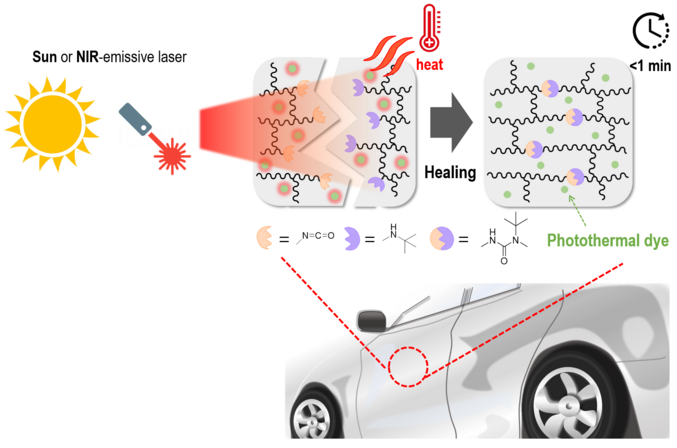Reviewed by Alex SmithAug 8 2022
Scientists have created a transparent protective coating material that can self-heal in 30 minutes when exposed to sunlight.
 Self-healing mechanism of eco-friendly protective coating material for vehicles, including dynamic polymer network and photothermal dye. Image Credit: Korea Research Institute of Chemical Technology (KRICT)
Self-healing mechanism of eco-friendly protective coating material for vehicles, including dynamic polymer network and photothermal dye. Image Credit: Korea Research Institute of Chemical Technology (KRICT)
The excellent durability of automotive coatings is the most important factor when it comes to protecting the surface of a vehicle. In addition, protective coating materials should be transparent and colorless so that the original color of the product can be seen. Yet, it is hard to ensure a self-healing function while satisfying all of these conditions.
High hardness and exceptional durability are accompanied by very poor self-healing performance in materials with free molecular movement, while the reverse is true for materials with high self-healing capacity but low durability.
Researchers from the Korea Research Institute of Chemical Technology (KRICT), led by Drs. Jin Chul Kim, Young Il Park, and Ji-Eun Jeong have created a transparent coating material that meets all of the aforementioned requirements, performs similarly to commercial protective coating materials, and can self-heal using only sunlight (Particularly near-infrared light in sunlight, in the wavelength range of 1,000 to 1,100 nm).
Surface scratches can be repaired using the self-healing protective substance in 30 minutes when exposed to sunlight. The study team used a spray-coating machine to coat a laboratory-scale model car to demonstrate the self-healing capabilities of the created coating material. The blemish vanished, and the surface of the coating material was restored after the model automobile spent around 30 minutes in midday sunlight.
The self-healing phenomenon’s guiding principle is that the surface temperature of the created material increases as sunlight is absorbed because light energy is transformed into thermal energy. The repeated dissociation and recombination of chemical bonds in the polymer structure is then enabled by the elevated surface temperature to self-heal a surface scratch.
The research team combined an already-existing commercial coating resin with a transparent photothermal dye and a dynamic chemical bond (Hindered urea structure) that can repeat the decomposition and recombination of the polymer structure so that dynamic chemical interaction can happen actively when exposed to sunlight.
Even though photothermal dyes have been used to study self-healing properties, most previous research has focused on inorganic compounds, which are challenging to use in industrial settings because coating materials need to be transparent. Additionally, the production of a photothermal effect in inorganic materials requires a significant quantity of light energy.
The research team used near-infrared light-absorbing transparent organic photothermal dyes. Near-infrared light can prevent large increases in the vehicle surface temperature because it is a long-wavelength energy source that makes up less than 10% of noon sunlight.
Additionally, organic photothermal dyes have several benefits for commercialization, including affordability, ease of paint blending, and the fact that their colorless inherent hue does not alter the product’s color.
Future applications for the self-healing material include coatings for construction materials, electrical equipment like computers and cellphones, and transportation applications. Additionally, it is anticipated that lowering the usage of dangerous organic solvents produced in huge quantities when repainting vehicles will help the world achieve carbon neutrality.
This research was published as an additional cover of the May 2022 issue of ACS Applied Polymer Materials, an international scientific and technological journal.
The developed technology is a platform technology that synthesizes self-healing coating materials using both inexpensive commercial polymer materials and photothermal dyes. It is expected to be widely used not only in automotive clearcoats but also in various applications.
Dr. Jin Chul Kim, Research Director, Korea Research Institute of Chemical Technology
Journal Reference:
Son, D. H., et al. (2022) Fast, Localized, and Low-Energy Consumption Self-Healing of Automotive Clearcoats Using a Photothermal Effect Triggered by NIR Radiation. ACS Applied Polymer Materials. doi.org/10.1021/acsapm.1c01768.